The Signal Analyzer Market is estimated to be valued at USD 1.8 billion in 2025 and is projected to reach USD 3.7 billion by 2035, registering a compound annual growth rate (CAGR) of 7.5% over the forecast period.
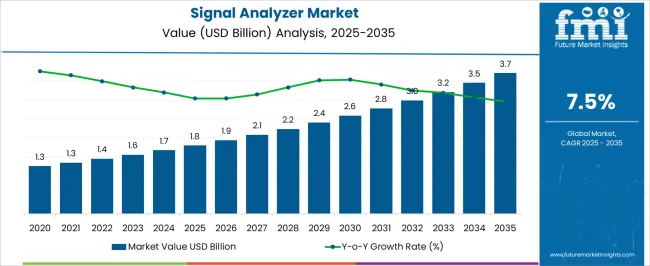
| Metric | Value |
|---|---|
| Signal Analyzer Market Estimated Value in (2025 E) | USD 1.8 billion |
| Signal Analyzer Market Forecast Value in (2035 F) | USD 3.7 billion |
| Forecast CAGR (2025 to 2035) | 7.5% |
The Signal Analyzer market is experiencing steady growth driven by increasing demand for high-precision signal measurement across communication networks, electronics testing, and industrial applications. The current market scenario is shaped by the adoption of advanced wireless and wired network infrastructures, the growing complexity of signal environments, and the need for accurate performance validation in emerging technologies such as 5G, IoT, and aerospace communications.
The market is being supported by rising investments in research and development for network optimization and system reliability. The ability to perform real-time signal analysis, spectrum monitoring, and modulation analysis through advanced software-enabled platforms has positioned signal analyzers as a critical tool for both testing and monitoring.
Future growth opportunities are anticipated in modular, software-upgradable devices that reduce the need for frequent hardware replacements As industries increasingly rely on high-speed data transmission and spectrum efficiency, the demand for versatile, high-accuracy signal analyzers is expected to continue rising, driving market expansion across both established and emerging sectors.
The signal analyzer market is segmented by network technology, type, product offerings, product type, end-use industry, and geographic regions. By network technology, signal analyzer market is divided into Wired and Wireless. In terms of type, signal analyzer market is classified into Vector Signal Analyzer, Swept-Tuned Signal Analyzer, Fast Fourier Transform Signal Analyzer, and Parallel Filter Signal Analyzer. Based on product offerings, signal analyzer market is segmented into Product and Software. By product type, signal analyzer market is segmented into Portable Signal Analyzer, Handheld Signal Analyzer, and Benchtop Signal Analyzer. By end-use industry, signal analyzer market is segmented into Electronics And Semiconductor, Healthcare, and IT & Telecommunication. Regionally, the signal analyzer industry is classified into North America, Latin America, Western Europe, Eastern Europe, Balkan & Baltic Countries, Russia & Belarus, Central Asia, East Asia, South Asia & Pacific, and the Middle East & Africa.
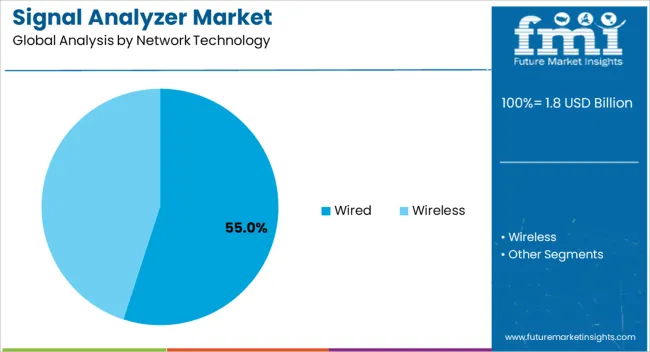
The Wired network technology segment is projected to hold 55.00% of the Signal Analyzer market revenue in 2025, making it the leading segment. This dominance is being attributed to the widespread deployment of wired communication networks in enterprise, industrial, and government infrastructures where high reliability and minimal signal loss are critical. The growth of this segment has been supported by increasing demand for network performance monitoring, interference detection, and precise bandwidth testing in high-density network environments.
Wired networks provide stable connections that are essential for accurate signal analysis, allowing analyzers to capture consistent and high-fidelity data. The ability to integrate wired signal analyzers into complex measurement systems and laboratory setups has further accelerated adoption.
Additionally, industries with stringent quality and regulatory requirements prefer wired networks for testing purposes, as they ensure reproducible results With continued investment in infrastructure modernization and high-speed data transmission networks, the wired segment is expected to retain its market leadership, offering dependable solutions for precise signal measurement and validation.
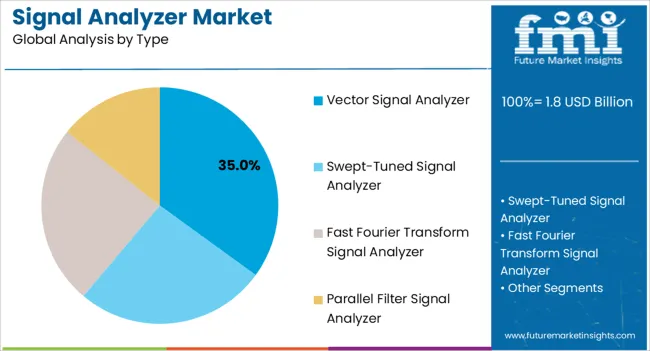
The Vector Signal Analyzer type segment is expected to account for 35.00% of the market revenue in 2025, emerging as the most prominent analyzer type. This prominence is being driven by the growing need for advanced signal characterization, including amplitude, phase, and frequency analysis across complex communication signals.
Vector signal analyzers allow detailed analysis of modulation, error vector magnitude, and spectral content, making them essential for wireless system validation, component testing, and research laboratories. Adoption has been reinforced by their ability to measure both baseband and RF signals accurately and the flexibility to integrate with software tools for automated testing.
The growth is also fueled by increasing demand in emerging communication technologies where precise waveform and spectral analysis is critical As industries continue to require higher levels of measurement accuracy, the vector signal analyzer type is expected to maintain its leadership due to its capability to provide comprehensive insights into complex signal behaviors, supporting the design, testing, and optimization of modern communication systems.
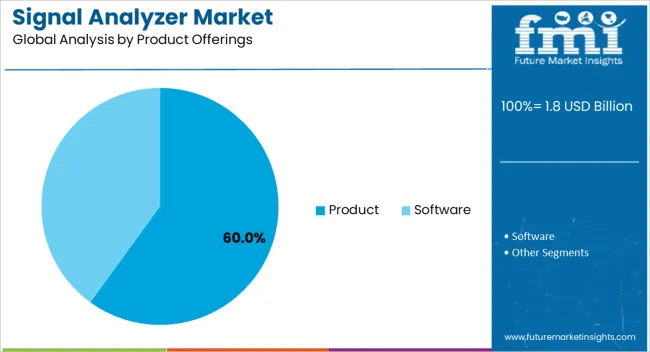
The Product offering segment is projected to hold 60.00% of the Signal Analyzer market revenue in 2025, establishing it as the leading offering type. This leadership is being attributed to the preference for turnkey, ready-to-use analyzer systems that deliver immediate functionality and high measurement accuracy.
The growth of this segment has been supported by increasing demand for packaged solutions in laboratory testing, industrial quality control, and communication network monitoring, where time efficiency and reliability are crucial. Product offerings provide standardized interfaces, calibrated measurement capabilities, and integrated software for analysis, reducing the need for extensive setup or customization.
Additionally, the ability to support multiple network technologies and analyzer types within a single product has strengthened its adoption As organizations prioritize operational efficiency, cost-effectiveness, and dependable performance, product offerings are expected to remain dominant, enabling users to deploy sophisticated signal analysis solutions without the complexities of custom-built setups.
Signal analyzer, an instrument that measures the magnitude and phase of the input signal at a single frequency within the bandwidth of an instrument. Signal analyzer can perform operations of both vector signal analyzer and spectrum analyzer. Signal analyzer can be viewed as a platform for measurement which performs various analysis which include noise, phase, power, distortion, and modulation and demodulation quality analysis.
Signal analyzer are available in various frequency range with the option of extension with external mixing solutions.
In the recent past, demand for the signal analyzer has thrived as a utilization of wave analysis has continued to increase which has resulted in a significant boom within the telecommunication industry. Increasing demand for wireless technology across the globe is found to be one of the most crucial factor assisting the growth of global signal analyzer market.
Further, increasing operation of LTE (long term evolution) services is projected to assist the market growth
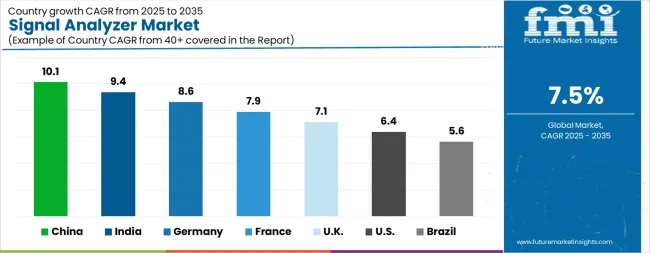
| Country | CAGR |
|---|---|
| China | 10.1% |
| India | 9.4% |
| Germany | 8.6% |
| France | 7.9% |
| UK | 7.1% |
| USA | 6.4% |
| Brazil | 5.6% |
The Signal Analyzer Market is expected to register a CAGR of 7.5% during the forecast period, exhibiting varied country level momentum. China leads with the highest CAGR of 10.1%, followed by India at 9.4%. Developed markets such as Germany, France, and the UK continue to expand steadily, while the USA is likely to grow at consistent rates. Brazil posts the lowest CAGR at 5.6%, yet still underscores a broadly positive trajectory for the global Signal Analyzer Market. In 2024, Germany held a dominant revenue in the Western Europe market and is expected to grow with a CAGR of 8.6%. The USA Signal Analyzer Market is estimated to be valued at USD 683.1 million in 2025 and is anticipated to reach a valuation of USD 1.3 billion by 2035. Sales are projected to rise at a CAGR of 6.4% over the forecast period between 2025 and 2035. While Japan and South Korea markets are estimated to be valued at USD 98.5 million and USD 47.2 million respectively in 2025.
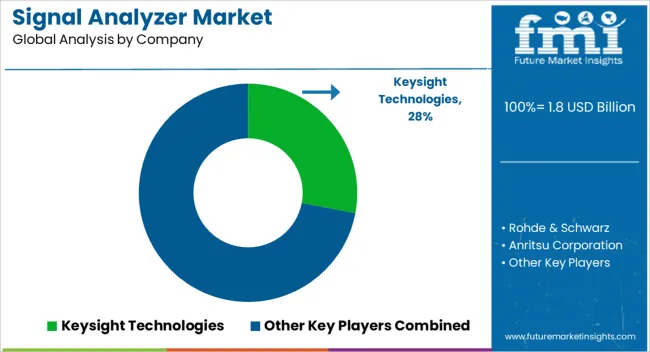
| Item | Value |
|---|---|
| Quantitative Units | USD 1.8 Billion |
| Network Technology | Wired and Wireless |
| Type | Vector Signal Analyzer, Swept-Tuned Signal Analyzer, Fast Fourier Transform Signal Analyzer, and Parallel Filter Signal Analyzer |
| Product Offerings | Product and Software |
| Product Type | Portable Signal Analyzer, Handheld Signal Analyzer, and Benchtop Signal Analyzer |
| End-Use Industry | Electronics And Semiconductor, Healthcare, and IT & Telecommunication |
| Regions Covered | North America, Europe, Asia-Pacific, Latin America, Middle East & Africa |
| Country Covered | United States, Canada, Germany, France, United Kingdom, China, Japan, India, Brazil, South Africa |
| Key Companies Profiled | Keysight Technologies, Rohde & Schwarz, Anritsu Corporation, National Instruments, Tektronix (A Fortive Company), Viavi Solutions, Spirent Communications, and EXFO |
The global signal analyzer market is estimated to be valued at USD 1.8 billion in 2025.
The market size for the signal analyzer market is projected to reach USD 3.7 billion by 2035.
The signal analyzer market is expected to grow at a 7.5% CAGR between 2025 and 2035.
The key product types in signal analyzer market are wired and wireless.
In terms of type, vector signal analyzer segment to command 35.0% share in the signal analyzer market in 2025.






Our Research Products

The "Full Research Suite" delivers actionable market intel, deep dives on markets or technologies, so clients act faster, cut risk, and unlock growth.

The Leaderboard benchmarks and ranks top vendors, classifying them as Established Leaders, Leading Challengers, or Disruptors & Challengers.

Locates where complements amplify value and substitutes erode it, forecasting net impact by horizon

We deliver granular, decision-grade intel: market sizing, 5-year forecasts, pricing, adoption, usage, revenue, and operational KPIs—plus competitor tracking, regulation, and value chains—across 60 countries broadly.

Spot the shifts before they hit your P&L. We track inflection points, adoption curves, pricing moves, and ecosystem plays to show where demand is heading, why it is changing, and what to do next across high-growth markets and disruptive tech

Real-time reads of user behavior. We track shifting priorities, perceptions of today’s and next-gen services, and provider experience, then pace how fast tech moves from trial to adoption, blending buyer, consumer, and channel inputs with social signals (#WhySwitch, #UX).

Partner with our analyst team to build a custom report designed around your business priorities. From analysing market trends to assessing competitors or crafting bespoke datasets, we tailor insights to your needs.
Supplier Intelligence
Discovery & Profiling
Capacity & Footprint
Performance & Risk
Compliance & Governance
Commercial Readiness
Who Supplies Whom
Scorecards & Shortlists
Playbooks & Docs
Category Intelligence
Definition & Scope
Demand & Use Cases
Cost Drivers
Market Structure
Supply Chain Map
Trade & Policy
Operating Norms
Deliverables
Buyer Intelligence
Account Basics
Spend & Scope
Procurement Model
Vendor Requirements
Terms & Policies
Entry Strategy
Pain Points & Triggers
Outputs
Pricing Analysis
Benchmarks
Trends
Should-Cost
Indexation
Landed Cost
Commercial Terms
Deliverables
Brand Analysis
Positioning & Value Prop
Share & Presence
Customer Evidence
Go-to-Market
Digital & Reputation
Compliance & Trust
KPIs & Gaps
Outputs
Full Research Suite comprises of:
Market outlook & trends analysis
Interviews & case studies
Strategic recommendations
Vendor profiles & capabilities analysis
5-year forecasts
8 regions and 60+ country-level data splits
Market segment data splits
12 months of continuous data updates
DELIVERED AS:
PDF EXCEL ONLINE
Signal Conditioning Modules Market Size and Share Forecast Outlook 2025 to 2035
Signals Intelligence (SIGINT) Market Size and Share Forecast Outlook 2025 to 2035
Signal Generator Market Analysis by Product, Technology, Application, End-use, and Region through 2035
Signaling Device Market – Industrial Safety & Automation
Signal Calibrators Market
Signal Transformer Market
Mixed Signal IC Market Size and Share Forecast Outlook 2025 to 2035
Small Signal Transistor Market Size and Share Forecast Outlook 2025 to 2035
Demand Signal Repository Solutions Market Size and Share Forecast Outlook 2025 to 2035
Traffic Signal Controller Market
Digital Signal Controller & Processor Market
Digital Signal Processors Market
Diameter Signaling Market Size and Share Forecast Outlook 2025 to 2035
Power And Signal Cables Market
Lane Control Signals Market Size and Share Forecast Outlook 2025 to 2035
Audible and Visual Signaling Devices Market Analysis by Product Type, End-Use Industry, and Region through 2035
Industrial Wireless Broken Signal Solutions Market Growth – Trends & Forecast 2025 to 2035
TOC Analyzer Market Size and Share Forecast Outlook 2025 to 2035
ESR Analyzer Market Analysis - Size, Share, and Forecast 2025 to 2035
XRF Analyzer Market Growth – Trends & Forecast 2019-2027

Thank you!
You will receive an email from our Business Development Manager. Please be sure to check your SPAM/JUNK folder too.
Chat With
MaRIA